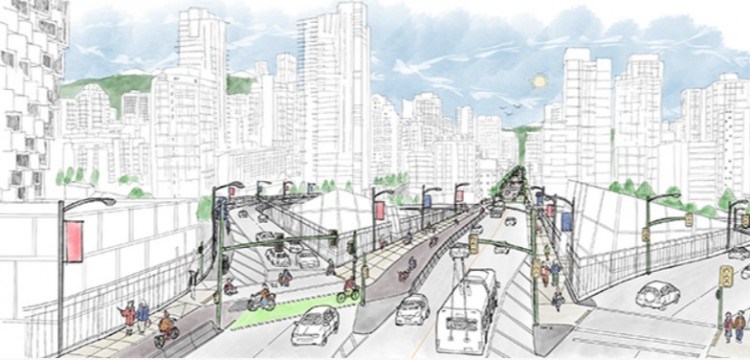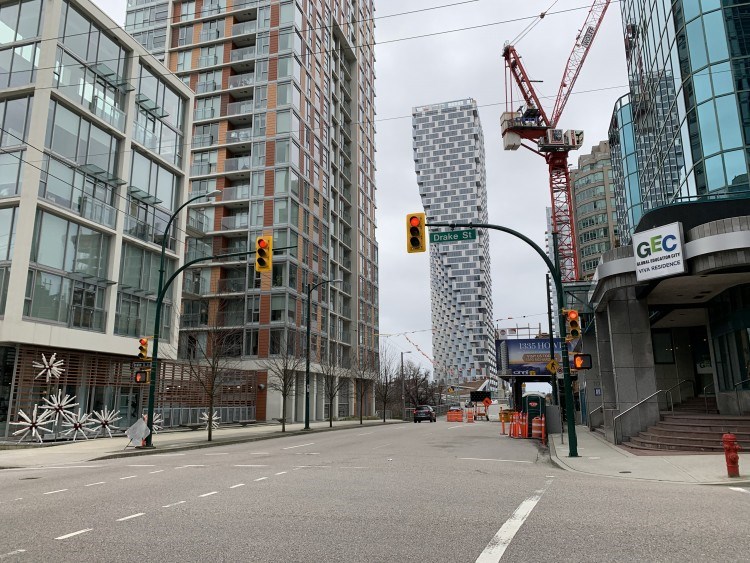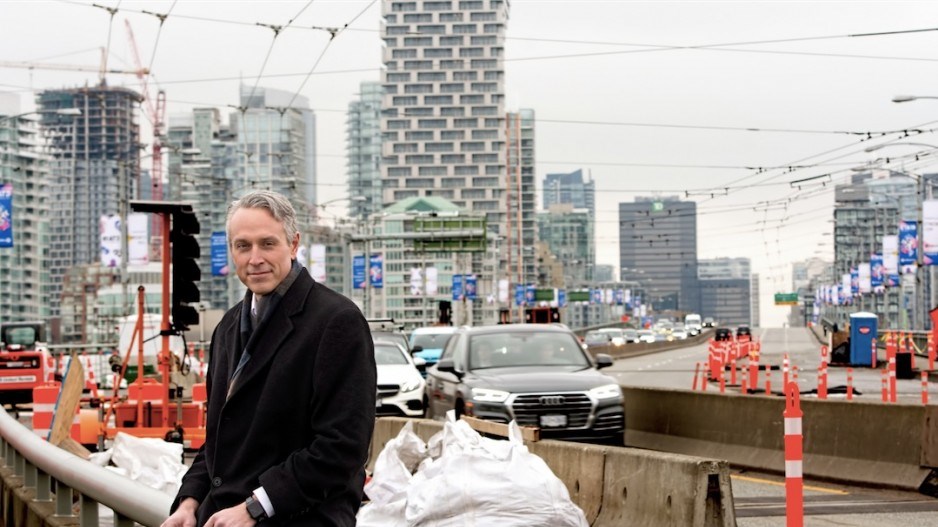Imagine rising in a large glass elevator from Granville Island to the middle of the Granville Bridge, looking west. The elevator tower leads to a platform that juts out from the bridge, where pedestrians disembark and either walk downtown or cross a bike lane to a bus stop.
The idea has been floated since late 2016 as part of the Granville Island 2040 planning project that the peninsula’s owner, Canada Mortgage and Housing Corp. (CMHC), commissioned.
CMHC has yet to earmark funding for the project or determine how much it is willing to spend to build on the amenity, but its manager of planning and development at Granville Island, Sebastian Lippa, told Business in Vancouver he believes that the elevator to the bridge is worth creating as a tourist attraction in its own right.
“Done well, the project could be a city-changing piece of infrastructure that would draw locals and out-of-town visitors as a must-do thing to do in Vancouver,” he said.
City of Vancouver manager of transportation design Paul Storer told BIV he believes that CMHC or other organizations would have to finance the bulk of the project to bring it to fruition.
He and Lippa agree that were an elevator to the Granville Bridge to be built, it would likely not be until at least the end of this decade. The design would also probably include multiple elevators, in case one needs service, and also because if the project is a success, there could be strong demand from those who live and work on Granville Island.
In the near term, Storer is focused on a $30 million to $40 million proposal for the Granville Bridge that would expand the west sidewalk, add a two-way bike lane between that sidewalk and vehicle traffic, upgrade the sidewalk on the bridge’s east side, remove two of the six vehicle-traffic lanes and add traffic signals on four bridge ramps.
The city would finance much of the proposed work, although it may be able to access some funding from TransLink, Storer said.
City staff examined 20 options for redesigning the bridge deck and narrowed the choices to six. Public input further narrowed the proposals to one, which Storer expects to present to city council for approval in April or May.

(Image: Here is a rendering of the proposed future design of the north end of the Granville Bridge | City of Vancouver)
Storer believes that the proposed option is the one that fits best with a future elevator. One early proposal that would not have worked as well with a future elevator would have included a raised centre-span platform for pedestrians and cyclists, he said.
“People were thinking we could bring the elevator through the middle of the bridge deck,” he said. “We did a feasibility study with Granville Island, and having the elevator come through the bridge deck didn’t make sense. That’s really, really difficult [and expensive] from a structural point of view.”
Chopping out part of the existing bridge deck to accommodate an elevator would also eat away at valuable bridge-deck space that Storer stressed is better used to move pedestrians, cyclists or vehicles. A pedestrian elevator up to the bridge deck would be a novel engineering feat. None of the local engineers or urban planners whom BIV asked could identify a comparable civil engineering achievement elsewhere in the world.
Brussels may come closest, with its Marolles lift, which connects Place Poelaert with the higher-grade Rue des Minimes.
A more immediate re-engineering feat that Vancouver city staff and subcontractors have devised for area bridges is how to improve traffic flow.
City staff have toiled for much of the last decade changing the division of square footage on the Burrard Bridge among pedestrians, cyclists and vehicles. One-way bike lanes were added on each side of that bridge. The city also tinkered with traffic flow on the Cambie Bridge in 2018, by removing a vehicle lane and adding a separated bike lane.
Overall, engineering changes on city bridges, however, are more sophisticated than simply putting a bike lane where a vehicle lane once was.
Work a few years ago at Burrard Bridge’s north end, at the west-side intersection, is an example. Gone is the single vehicle lane that previously provided access for drivers to merge into southbound traffic on the bridge.
Instead, Pacific Boulevard has two lanes that allow vehicles to turn right onto the bridge when a new traffic signal light turns green. Vehicles heading eastward on Pacific Boulevard across Burrard Street are newly restricted to one lane, from the previous two lanes.
The city engineered a similar solution to traffic congestion at Marine Drive and Knight Street.
Drivers previously had one lane off the Knight Street Bridge to merge with eastbound traffic on Marine Drive. The new arrangement has two lanes off the bridge, going east, and a traffic light that regulates traffic.
Storer’s proposal for vehicle-traffic changes on the Granville Bridge includes four sets of traffic signals on on-ramps and off-ramps.
“It’s something we’ve worked on in quite a fair amount of detail,” he said. “Basically we need the signals there to stop cars so that it’s safe and comfortable for people to walk and bike across. We can do that without impacting capacity or having serious impacts on travel time.”
The city’s plan is to co-ordinate the proposed traffic signal on the southbound Howe Street on-ramp to the Granville Bridge, for example, with traffic signals one block away, at the corner of Howe and Drake streets.

(Image: The traffic signals at the corner of Howe and Drake streets are expected to be synchronized with ones at the top of the on-ramp, just before drivers enter the main span of the Granville Bridge | Glen Korstrom)
Drivers going north through the Drake Street intersection on a green light could then be reasonably sure that they will get a green light when they get to the traffic signal on the bridge, around the spot where the Vancouver House condo tower rises above the bridge, he said.
“We’re still figuring out the timeline for the project,” Storer added.
Assuming council approves the project, about $25 million of the work could be done within the capital plan that extends until 2022. The rest of the work would then be done under a future capital plan.
“It’s like with the Burrard Bridge,” Storer said.
“We phased in Burrard in three different phases of improvements to the bridge and intersection.” •




